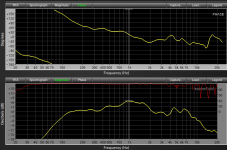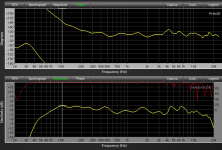Some audio “purists” abhor the use of tone controls or equalization because they cause phase shift.
As it turns out, frequency response problems are usually accompanied by phase shifts, fix one and you fix the other.
The shots below show a 5” full range speaker, raw response is about +/-6 dB from 90 to 10K, phase response is +150 to -35 degrees or so over that range.
EQd to +/- 3dB from 60-16K the phase response smooths out considerably, and the speaker sounds much better.
Although I am not a big fan of “full range” speakers, the flat phase response over a wide range is compelling.
Phase response as smooth as this cheap speaker is very difficult to achieve with passive multi-way systems.
As it turns out, frequency response problems are usually accompanied by phase shifts, fix one and you fix the other.
The shots below show a 5” full range speaker, raw response is about +/-6 dB from 90 to 10K, phase response is +150 to -35 degrees or so over that range.
EQd to +/- 3dB from 60-16K the phase response smooths out considerably, and the speaker sounds much better.
Although I am not a big fan of “full range” speakers, the flat phase response over a wide range is compelling.
Phase response as smooth as this cheap speaker is very difficult to achieve with passive multi-way systems.
Attachments
Yup. If your measurement screen will unwrap the phase response and the propagation delay is correctly calculated, the portion of the response that is linear phase or not changing rapidly will be a mirror image of the magnitude response and is correctable with EQ.
Since time and frequency are recipricals of one another an aberration in one domain gives a disturbance in the other and so stands to reason that a correction in the frequency domain will also show an improvement in the time domain. It's odd how sharply and often that fact is denied.
All the best,
Barry.
Since time and frequency are recipricals of one another an aberration in one domain gives a disturbance in the other and so stands to reason that a correction in the frequency domain will also show an improvement in the time domain. It's odd how sharply and often that fact is denied.
All the best,
Barry.
The increased LF level would cause THD to be higher at a lower SPL level than the unequalized response, as well as increase IMD.How does distortion change (or not) with the EQ? Can you break out the harmonics?
The speakers were originally used in pairs directly behind driver and passenger's head in an electric car, at about 6 inches from each ear (Texas headphones
With that much boost, they would distort at a fairly low level for normal size room use, I'd only use them with a sub below.
It would be more work than it is worth to break out the harmonics, as I don't have a dedicated distortion analyzer, I'd have to run discreet tones, and look at the harmonics on Smaart's RTA, then have to hear how that method is bogus
Art
- Status
- This old topic is closed. If you want to reopen this topic, contact a moderator using the "Report Post" button.

